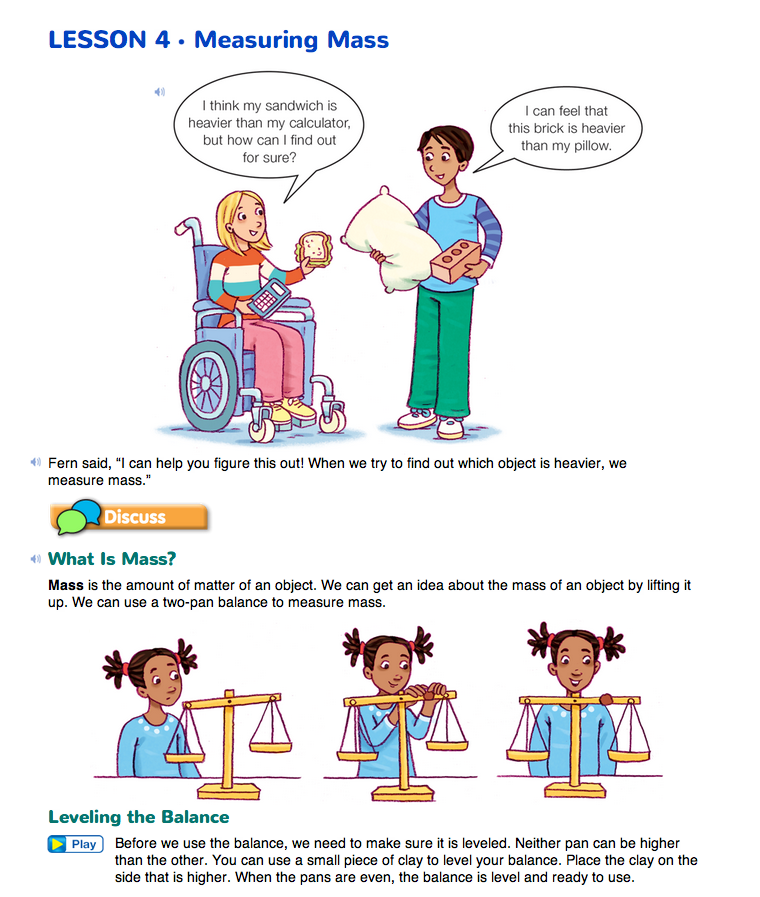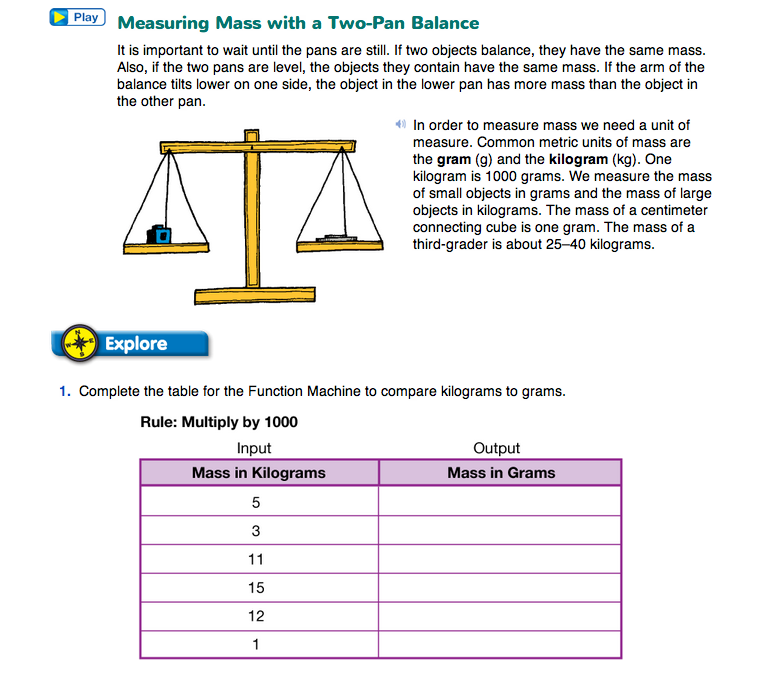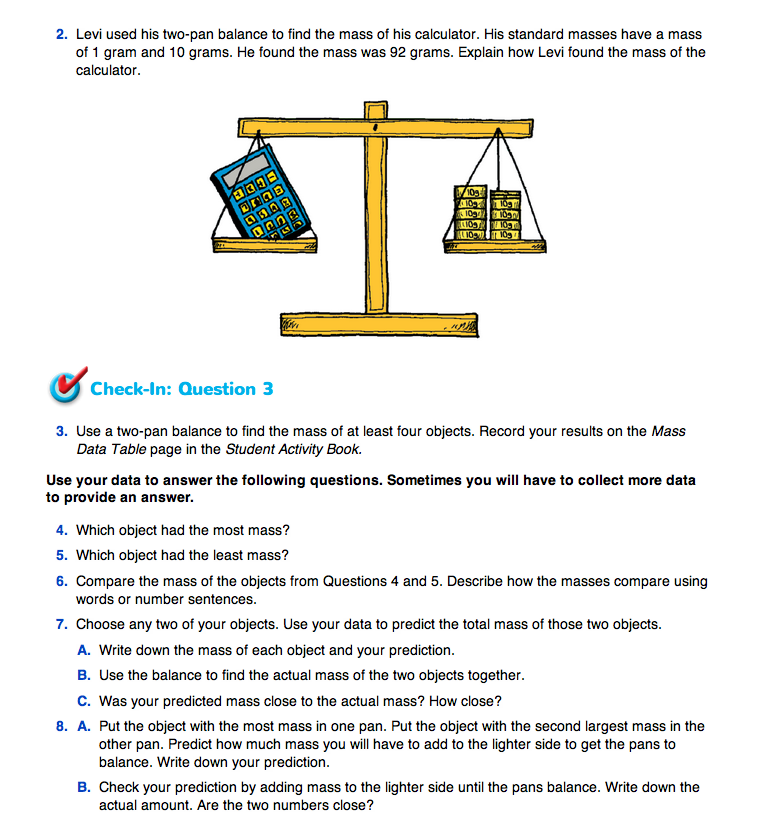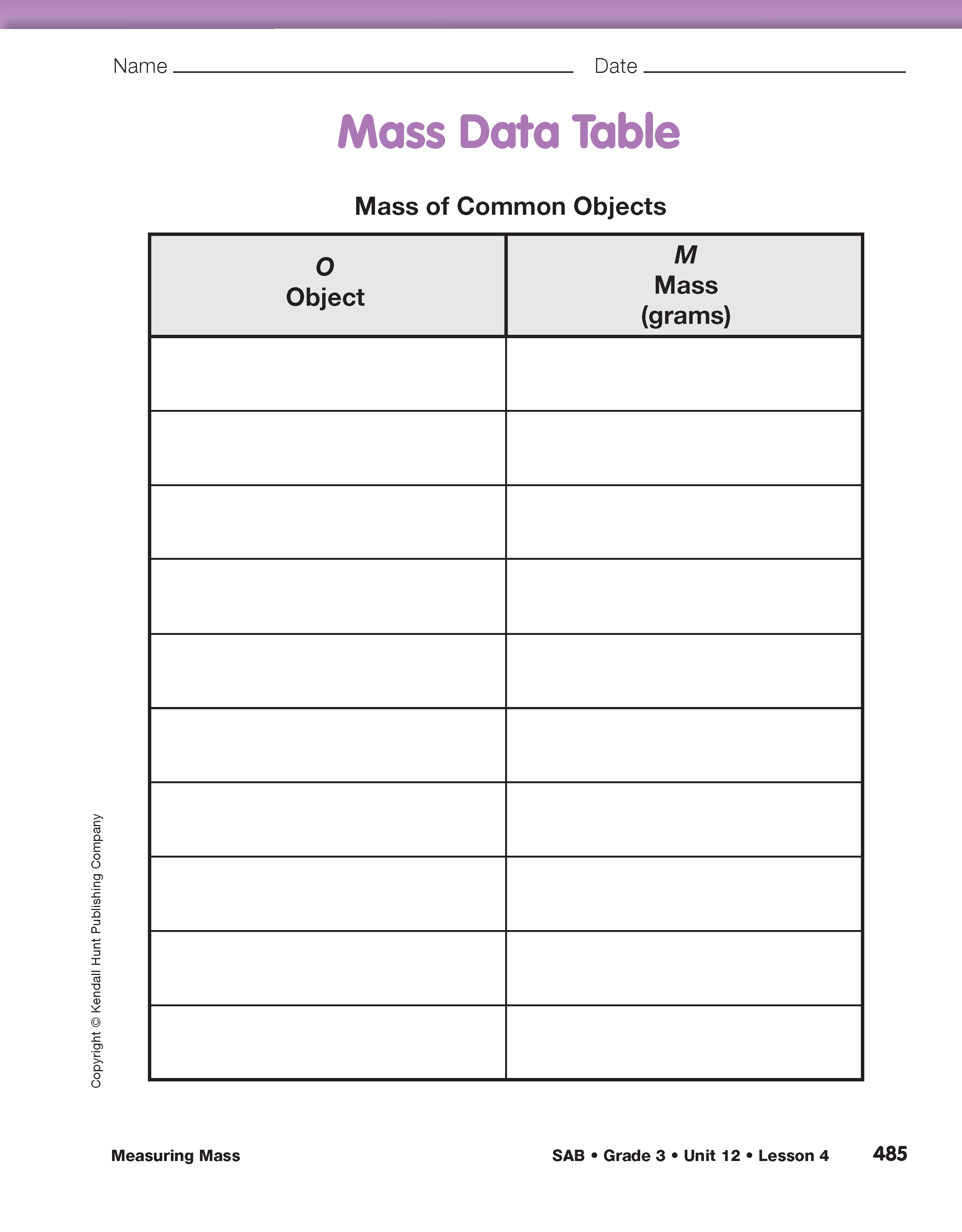
Terminology for Mass and Weight. Mass is one of the most difficult variables to understand. Basically, mass is a measure of the quantity of matter in an object. Math Trailblazers encourages third-grade students to use familiar language when learning to measure mass. At times, we use examples that refer to weight when we are actually finding the mass of an object. For example, students may say that they are “weighing” a pencil instead of finding the mass of the pencil. Traditionally, we use a two-pan balance to find the mass of an object and a spring scale (for example, a bathroom scale) to weigh an object.
Mass, Weight, and Gravity. An object has mass, for instance, 10 grams. That makes it heavy enough to weigh 10 grams on earth because an object's weight depends on how strongly gravity is pulling on it. With less gravitational pull, the object would weigh less, but its mass would still be 10 grams. The object's weight changed, but its mass did not. In the third grade, students are only expected to be familiar with an object's mass and weight on Earth, so it is acceptable for them to use the terms weight and mass interchangeably.
Students will go into more depth about mass versus weight in Grade 4 of Math Trailblazers.
What Is Mass?
Introduce the lesson by asking students:
- Why would you want to know how heavy something is? (Possible responses: An adult might want to know a child's weight in order to determine the right dosage of medicine, a consumer might want to know the weight of two boxes of cereal so that she can figure out which is a better buy, a truck driver might want to know how much his truck weighs to see if it is within the weight limit for a bridge. See Content Note.)
- How can we determine how heavy something is? (Possible responses: lift it up; weigh it)
- We measure length in inches and centimeters. Can you name some units of measure for weight? (pounds, ounces, grams, kilograms)
Use the Measuring Mass pages in the Student Guide to introduce students to mass, measuring mass, and the gram. As you talk, watch for common error: confusing mass with size or density. A smaller object can have a larger mass; a larger object can have a smaller mass. But a pound of feathers has the same mass as a pound of lead.
Read and discuss the opening vignette and the What is Mass? section on the Measuring Mass page. The students on the page wonder how they can measure how heavy something is. If available, show students the actual objects that are discussed in the vignette: a sandwich, a calculator, a brick, and a pillow. Students are introduced to the two-pan balance. See Content Note.
The two-pan balance is the key to our operational definition of mass for children. If two objects balance, they have the same mass. If the arm tilts lower on one side, the object in the lower of the two pans has more mass than the object in the other pan.
Leveling the Balance. Read the Leveling the Balance section together as a class. Then distribute a two-pan balance to each student group. When you
first assemble the balances, some of them will probably not balance perfectly with the pans empty.
- Do you think you will get a fair reading from a balance that is not level? (No)
Students will see the need to level the balance. To do so, it may be necessary to add a small piece of clay to one of the arms. It takes a little patience to discover the right size for the piece. This activity is important because it teaches students to take responsibility for the accuracy of the measurement instrument.
Measuring Mass with a Two-Pan Balance. Read the Measuring Mass with a Two-Pan Balance section in the Student Guide together as a class.
Demonstrate using a two-pan balance while reminding students of the following:
- Level the balance.
- Measure carefully.
- Make sure the pans are still before adding or removing masses.
- Balance the two pans as closely as possible.
- Add the standard masses correctly.
Distribute a set of standard masses to each student group. With their balances level, students are ready to begin finding the mass of small objects.
To begin, ask students to:
- Balance a 5-gram mass with five 1-gram masses.
- Balance a 10-gram mass with two 5-gram masses.
- Balance a 10-gram mass with ten 1-gram masses.
- What standard masses can you use to balance one 20-gram mass? Try it and see if you are correct. (Possible responses: two 10-gram masses; four 5-gram masses; one 10-gram mass and ten 1-gram masses)
Record students' responses in the form of number sentences. For example, for two 10-gram masses, display the number sentence 1 × 20 = 2 × 10.
Distribute the items you collected to student groups. (See Materials Preparation). Ask students to take out the Mass Data Table page in the Student Activity Book. Assign Questions 1–10 in the Student Guide to student groups. Students will find the mass of several items in Question 3, record their data on the Mass Data Table page, and then answer Questions 4–10.
You should have enough of one item so each group can find the mass of an identical object. There are two reasons to have the groups mass one common object. First, it will be easier to see whether the measurements are close to the correct mass, enabling you to easily spot groups having trouble. Second, different measurements for identical objects will motivate a discussion of measurement error.
Observe students using two-pan balances to mass objects in Check-In: Question 3 of the Student Guide to assess their abilities to measure mass in grams [E6] and collect and organize data in a table [E7]. While students measure the mass of their objects, use the Measuring Mass Check-In: Question 3 Feedback Box Assessment Master to record your observations:
- Can students level the two-pan balance properly?
- Were they careful to balance the two pans as closely as possible?
- Are students' measurements of the common object within an appropriate range? If not, did they add the standard masses incorrectly?

















